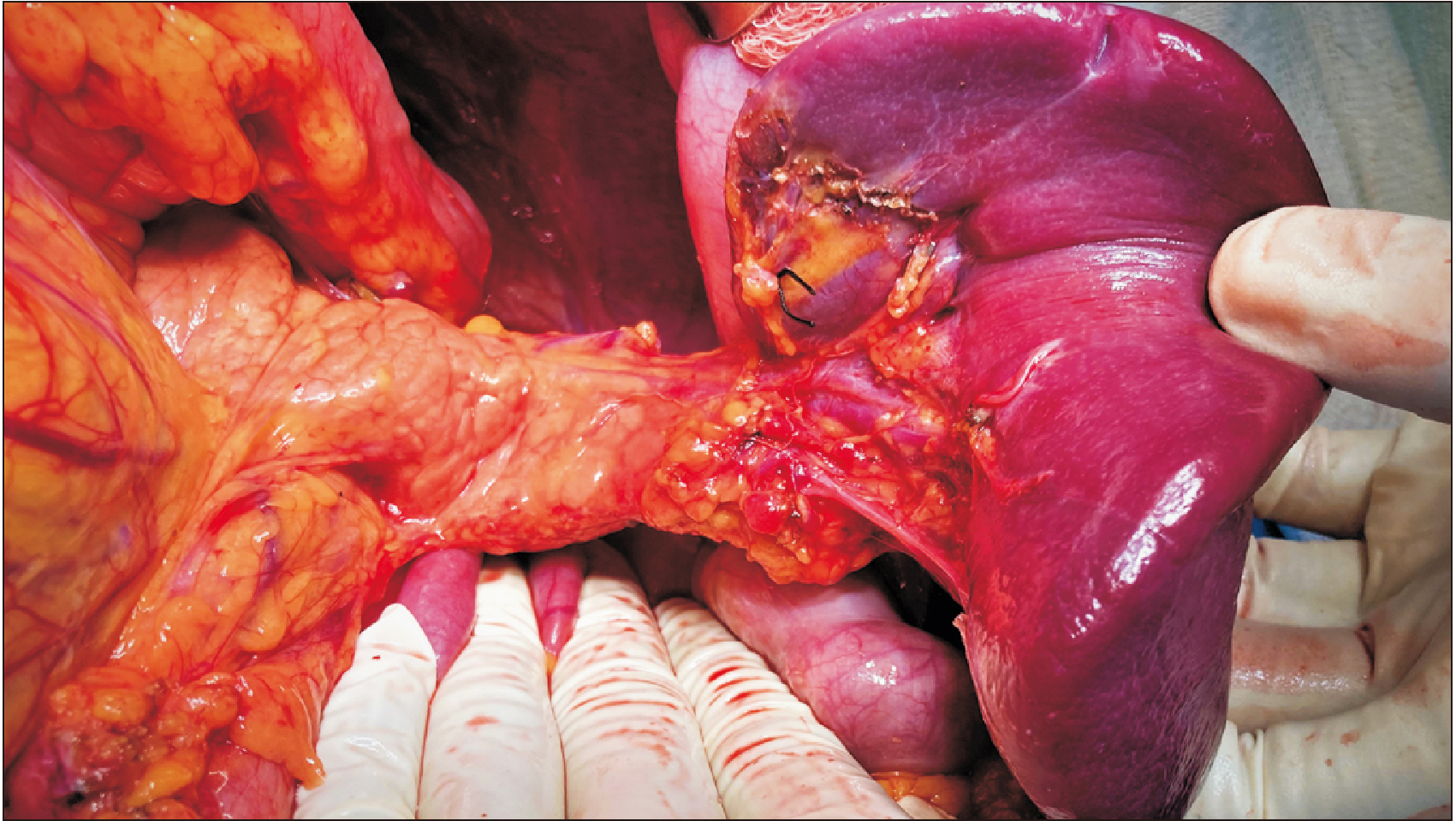Ann Hepatobiliary Pancreat Surg.
2024 Feb;28(1):48-52. 10.14701/ahbps.23-080.
Early mobilization and delayed arterial ligation (EMDAL) as a surgical technique for splenectomy and shunt surgery in portal hypertension
- Affiliations
-
- 1Department of Surgical Gastroenterology, JIPMER, Puducherry, India
- KMID: 2553365
- DOI: http://doi.org/10.14701/ahbps.23-080
Abstract
- Backgrounds/Aims
Splenectomy is the most frequently performed procedure as definitive management or as part of shunt surgery or devascularization in portal hypertension. Splenectomy is technically challenging because of the frequent coexistence of multiple collateral varices, splenomegaly, poor liver function, and thrombocytopenia. Early arterial ligation and late mobilization (EALDEM) is the traditional method for splenectomy in portal hypertension. Early spleen mobilization offers good control of the hilum. We aim to compare the effect of the early mobilization and delayed arterial ligation (EMDAL) technique with that of the conventional splenectomy technique in patients with portal hypertension.
Methods
During the study period from September 2011 to September 2022, 173 patients underwent surgical intervention for portal hypertension at our institution. Among these patients, 114 underwent the conventional method of splenectomy (early arterial ligation and late splenic mobilization) while 59 underwent splenectomy with the EMDAL technique. Demographics were compared between the two groups. Intraoperative and postoperative outcomes were analyzed using the Mann-Whitney test in each group. A minimum follow-up of 12 months was performed in each group.
Results
Demographics and type of surgical procedure were comparable in the two surgical method groups. Median blood loss was higher in the conventional group than in the EMDAL method. The median duration of surgery was comparable in the two surgical procedures. Clavien-Dindo grade III/IV complications were reported more frequently in the conventional group.
Conclusions
The splenic hilum can be controlled well and bleeding can be minimised with early mobilization and delayed arterial ligation.
Keyword
Figure
Reference
-
1. Henderson JM, Anderson CD. 2020; The surgical treatment of portal hypertension. Clin Liver Dis (Hoboken). 15:S52–S63. DOI: 10.1002/cld.877. PMID: 32140214. PMCID: PMC7050955.
Article2. Chen XD, He FQ, Yang L, Yu YY, Zhou ZG. 2013; Laparoscopic splenectomy with or without devascularization of the stomach for liver cirrhosis and portal hypertension: a systematic review. ANZ J Surg. 83:122–128. DOI: 10.1111/ans.12003. PMID: 23170929.
Article3. Dionigi R, Boni L, Rausei S, Rovera F, Dionigi G. 2013; History of splenectomy. Int J Surg. 11 Suppl 1:S42–S43. DOI: 10.1016/S1743-9191(13)60013-8. PMID: 24380550.
Article4. Watanabe Y, Horiuchi A, Yoshida M, Yamamoto Y, Sugishita H, Kumagi T, et al. 2007; Significance of laparoscopic splenectomy in patients with hypersplenism. World J Surg. 31:549–555. DOI: 10.1007/s00268-006-0504-8. PMID: 17308852.
Article5. Zhu JH, Wang YD, Ye ZY, Zhao T, Zhu YW, Xie ZJ, et al. 2009; Laparoscopic versus open splenectomy for hypersplenism secondary to liver cirrhosis. Surg Laparosc Endosc Percutan Tech. 19:258–262. DOI: 10.1097/SLE.0b013e3181a6ec7c. PMID: 19542858.
Article6. Wang Y, Zhan X, Zhu Y, Xie Z, Zhu J, Ye Z. 2010; Laparoscopic splenectomy in portal hypertension: a single-surgeon 13-year experience. Surg Endosc. 24:1164–1169. DOI: 10.1007/s00464-009-0744-4. PMID: 20033218.
Article7. Zhan XL, Ji Y, Wang YD. 2014; Laparoscopic splenectomy for hypersplenism secondary to liver cirrhosis and portal hypertension. World J Gastroenterol. 20:5794–5800. DOI: 10.3748/wjg.v20.i19.5794. PMID: 24914339. PMCID: PMC4024788.
Article8. Kawanaka H, Akahoshi T, Kinjo N, Konishi K, Yoshida D, Anegawa G, et al. 2009; Technical standardization of laparoscopic splenectomy harmonized with hand-assisted laparoscopic surgery for patients with liver cirrhosis and hypersplenism. J Hepatobiliary Pancreat Surg. 16:749–757. DOI: 10.1007/s00534-009-0149-8. PMID: 19629372.
Article9. Tsutsumi N, Tomikawa M, Akahoshi T, Kawanaka H, Ota M, Sakaguchi Y, et al. 2016; Pancreatic fistula after laparoscopic splenectomy in patients with hypersplenism due to liver cirrhosis: effect of fibrin glue and polyglycolic acid felt on prophylaxis of postoperative complications. Am J Surg. 212:882–888. DOI: 10.1016/j.amjsurg.2015.12.028. PMID: 27162072.
Article10. Özcan B, Çevener M, Deveci B, Karadoğan I, Erdoğan O. 2018; Efficacy of endoscopic vascular staplers for splenichilar control during laparoscopic splenectomy. Laparosc Endosc Surg Sci. 25:87–92. DOI: 10.14744/less.2018.59489.11. Bhavsar MS, Vora HB, Khiria LS, Giriyappa VH. 2012; Portal hypertension: effect of early splenic artery ligation on platelets count during splenectomy. Saudi J Gastroenterol. 18:380–383. DOI: 10.4103/1319-3767.103430. PMID: 23150024. PMCID: PMC3530993.
Article
- Full Text Links
- Actions
-
Cited
- CITED
-
- Close
- Share
- Similar articles
-
- Lessons Learned from Inappropriate Ligation of the Left Renal Vein for a Large Splenorenal Shunt in Living Donor Liver Transplantation
- Distal pancreatectomy with splenorenal shunt to preserve spleen in a cirrhotic patient
- Ectopic Variceal Bleeding from the Hepaticojejunostomy due to Extrahepatic Portal Vein Occlusion: How to Treat?
- Analysis of a Distal Splenorenal Shunt for Treatment of Variceal Bleeding
- A Case of Pancreatic Arteriovenous Malformation with Portal Hypertension: Treatment with Transjugular Intrahepatic Portosystemic Shunt


